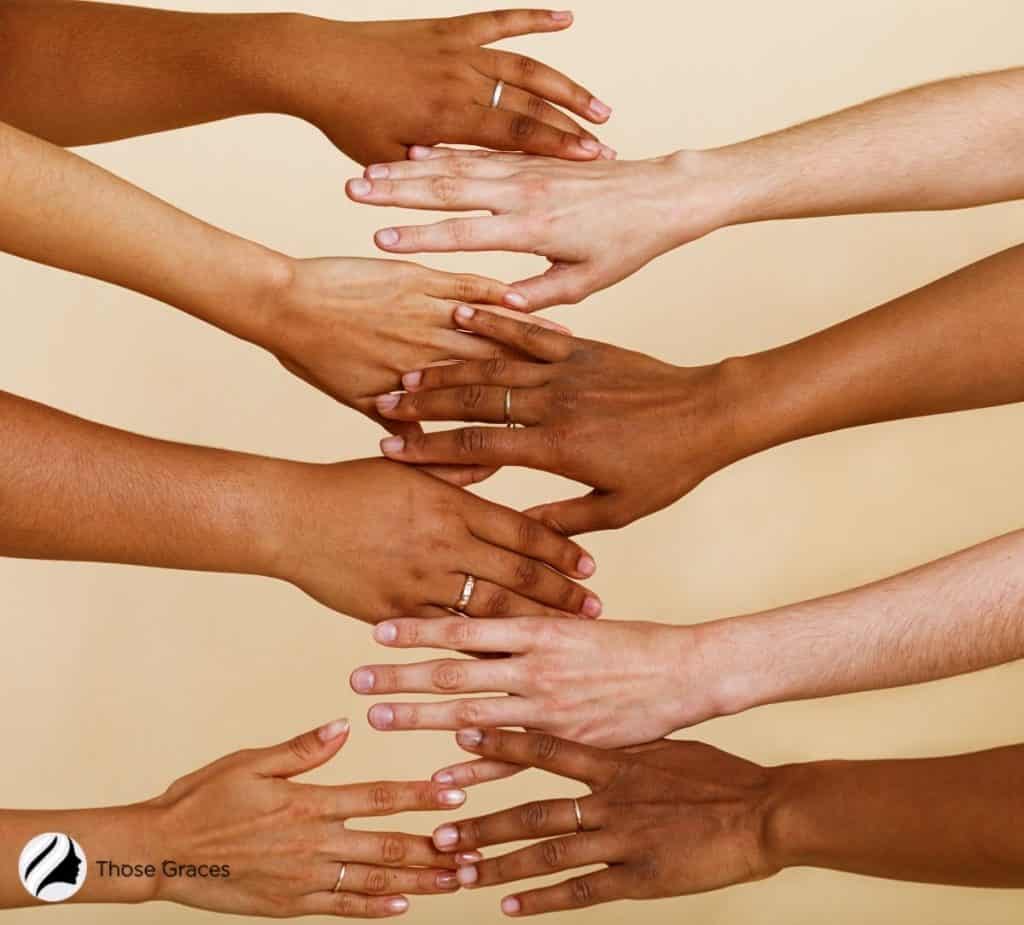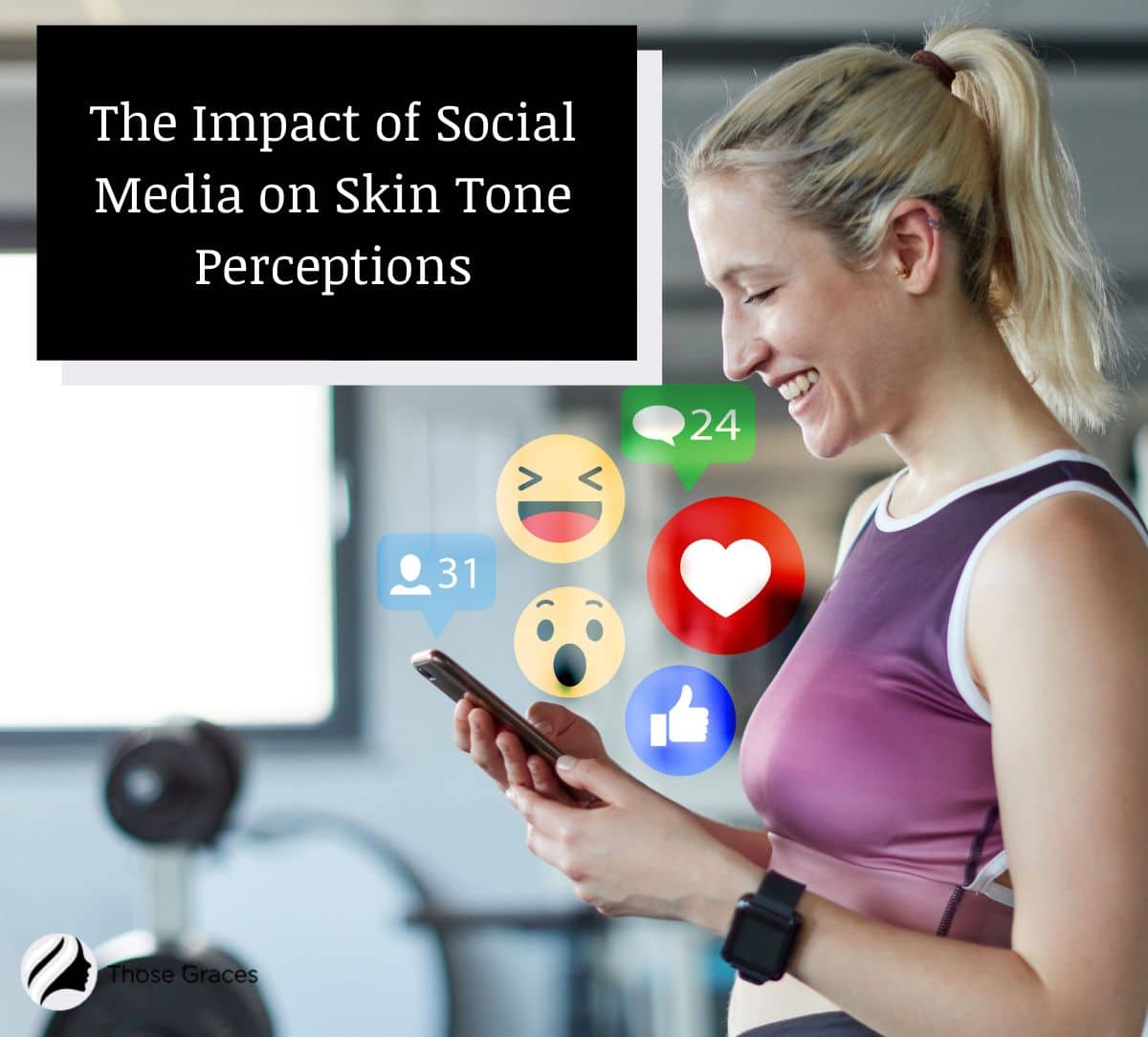Does scrolling through social media leave you feeling uneasy about your skin tone? Read on!
As someone venturing through the digital world, I’m alarmed, yet not surprised, by a study indicating that 72% of participants have experienced colorism at work or school [1].
This post is your compass for navigating this complex and evolving issue – and provides tried and tested solutions I’ve personally used to combat the negative effects of skin retouching and colorism.
Scroll down where I’ll reveal the gigantic impact of social media on skin tone perceptions (and what you can do about it)…
Key Takeaways
- Social media significantly affects how we perceive skin tone, often amplifying harmful biases and unrealistic beauty standards.
- Awareness and education are potent tools for breaking the cycle of negative impact on individuals’ self-perception due to colorism.
- Changing our consumption patterns on social media can be a transformative step toward fostering a more positive self-view and world perspective.
4 Impacts of Social Media on Skin Tone Perceptions | What You Should Know
With its influx of filtered images, social media shapes society’s perception of skin tone, increases people’s insecurities, and promotes lighter skin as the ideal – AND it’s getting worse…
Here’s a breakdown of these effects..
#1 Amplified Insecurities
Social media, overflowing with filtered and edited images, can worsen existing insecurities regarding your skin tone.
However, tools like the Fitzpatrick Skin Type Chart can offer a more scientific and unbiased approach to understanding skin tones and their unique needs.
Being perpetually bombarded with ‘flawless’ skin images sets unrealistic standards that will make you feel compelled to attain them psychologically and financially.
Being perpetually bombarded with flawless skin adverts is mentally taxing, creating the illusion that we’re not good enough.
What’s worse, there’s a biased standard – psychologically and financially – that makes you compelled to attain it.
Check out Michelle Pan’s discussion about the truth about skin filters:
#2 The Rise of Dysmorphia
Cases such as “Snapchat dysmorphia,” are not only probing people to seek cosmetic procedures to resemble their filtered images but have unsettling consequences…
In fact, studies performed by the American Academy of Facial Plastic and Reconstructive Surgery show another concern: Oftentimes, people will become dissatisfied with how they look after creating a digital depiction of a supposed “ideal self.” [2].
The result? Such feelings worsen and continue to corrupt a vulnerable self-image. The Perfect self is the goal. But the premises for how to achieve such a self is clouded.
#3 Impacts on Mental Health
As expected, a rising impact on mental health correlates with social media use – especially how depression and anxiety correlate with an illusion of a digitally created ideal self.
Alongside these digitally altered images, genuine tools like the color palette for tan skin can help individuals understand and appreciate their unique complexion without the pressure of conforming to digitally altered standards.
To support this, studies show that altered images can contribute to body dissatisfaction and negative self-perception, especially among younger men and women [4].
#4 Racial and Cultural Implications
People changing their skin tone in social media images can perpetuate a narrow and often Eurocentric standard of beauty.
This can damage people of color, who might feel pressure to lighten their skin to conform to these digital norms.
As a general outcome of the dangers of what’s happening above, take a second to observe the reality of social media on teenagers (and even kids!)…
Let me turn your attention to the dangers of skin tone filters and editing apps (and how they destroy our self-image)…
The Rise of Skin Tone Filters and Editing Apps
Have you noticed the subtle shift towards a lighter skin tone in social media photos?
This transformation isn’t accidental; it’s a digital design driven by skin tone filters and editing apps.
These tools became universal, reshaping our perception of beauty and exacerbating skin color stratification.
The Allure of Light Skin Tones
These apps and filters often default to lightening one’s complexion, subtly pushing users towards a ‘preferred’ skin tone—a standard often mirroring lighter skin tones.
For African Americans and other dark skin tones, this can compound issues tied to colorism and further entrench harmful biases.
The Psychological Distress
Beyond just aesthetics, this trend affects psychological well-being.
Data suggests a correlation between the frequent use of such filters and increased levels of psychological distress.
This distress is tied to beauty standards and a history of skin tone discrimination and bias for American women, especially African Americans.
Questioning the Norms
The persistent association between lighter skin tones and beauty is a striking example of skin tone stratification.
We must interrogate who sets these standards and understand their broader societal implications, including the effects on mental health and interpersonal relationships for individuals with darker skin tones.
The Push for Authenticity and Mental Health
As awareness grows, there is a burgeoning movement towards rejecting these filters and advocating for authentic representation of all skin tones—from the lightest to the darkest.
This pushback is about redefining beauty standards and fostering a healthier social environment and mental health.
Let’s delve into the initiatives challenging these digital norms and the potential for redefining beauty in our increasingly interconnected world.
Educational Initiatives To Motivate Healthy Skin Tone Perceptions | 3 Possible Solutions
With society’s obsession with social media, people’s general perception of beauty standards, educational initiatives, and general well-being are shifting – but there’s hope…

Luckily, educational initiatives are coming to the rescue, shining a light on this issue and presenting several comebacks…
#1 Programs and Initiatives
One noteworthy example is illustrated in the study “Skin Tone Representation in Dermatologist Social Media Accounts” [3].
This study highlights dermatology professionals’ responsible use of social media to portray a realistic and inclusive spectrum of skin tones [3].
#2 Parents and Educators
Parents and educators are vital in this educational endeavor.
They have the power to introduce children to diverse representations of beauty and teach them to analyze images they encounter online critically.
Conversations about using filters and editing apps that contribute to distorted skin tones can start early, fostering media literacy and healthy self-perception.
#3 Social Media Platforms
In a world where lighter skin tones are often disproportionately represented, these educational initiatives invite social media platforms themselves to be part of the solution.
This could be through implementing features that promote more natural and diverse images or by offering tools and resources for users struggling with related mental health issues.
Formal and informal education can be potent in reshaping perceptions in this digital age.
As we delve further, we will explore the real-world implications of these skewed perceptions, highlighting the urgency and importance of these educational initiatives.
FAQs
1. How does social media directly influence skin tone perceptions?
2. What can individuals do to counteract these influences?
3. How widespread is the issue of colorism due to social media?
Conclusion
The impact of social media on skin tone perceptions is a severe problem that can’t be ignored.
These platforms, meant to connect us, often subtly steer our perceptions of beauty and self-worth, sometimes to detrimental effects.
This article, guided by data and expert analysis, discussed the complex relationship between social media, skin tone perceptions, and self-esteem.
As society progresses in this increasingly digital world, arm yourself with awareness, education, and kindness!
Together, we can foster a digital environment that celebrates, not stifles, the beautiful diversity of human skin tones.
Resources
1. Massey, et al., SO. The Effects of Colorism on Self Perception and Self-Esteem [Internet]. Auctores. Available from: https://www.auctoresonline.org/article/the-effects-of-colorism-on-self-perception-and-self-esteem
2. Solutions TK ISG. American Academy of Facial Plastic and Reconstructive Surgery [Internet]. American Academy of Facial Plastic and Reconstructive Surgery. 2019. Available from: https://www.aafprs.org/AAFPRS/News-Patient-Safety/Annual_Survey.aspx
3. Paradkar KA, Kaffenberger JA. Skin Tone Representation in Dermatologist Social Media Accounts. The Journal of clinical and aesthetic dermatology [Internet]. 2022 [cited 2023 Aug 16];15:40–2. Available from: https://www.ncbi.nlm.nih.gov/pmc/articles/PMC9651156/
4. Roberts JE, Monroe SM. A multidimensional model of self-esteem in depression. Clinical Psychology Review. 1994;14:161–81.



